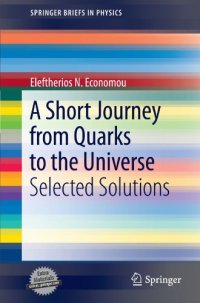
Ebook: A Short Journey from Quarks to the Universe
Author: Eleftherios N. Economou (auth.)
- Tags: Atomic Molecular Optical and Plasma Physics, Astrophysics and Astroparticles, Classical and Quantum Gravitation Relativity Theory, Optics and Electrodynamics, Applied Earth Sciences
- Series: SpringerBriefs in Physics 1
- Year: 2011
- Publisher: Springer-Verlag Berlin Heidelberg
- Edition: 1
- Language: English
- pdf
This book takes the reader for a short journey over the structures of matter showing that their main properties can be obtained even at a quantitative level with a minimum background knowledge. The latter, besides some high school physics and mathematics, consists of the three cornerstones of science presented in chapters 1 to 3, namely the atomic idea, the wave-particle duality, and the minimization of energy as the condition for equilibrium. Dimensional analysis employing the universal constants and combined with “a little imagination and thinking”, to quote Feynman, allows an amazing short-cut derivation of several quantitative results concerning the structures of matter. This book is expected to be of interest to physics, engineering, and other science students and to researchers in physics, material science, chemistry, and engineering who may find stimulating the alternative derivation of several real world results, which sometimes seem to pop out the magician’s hat.
This book takes the reader for a short journey over the structures of matter showing that their main properties can be obtained even at a quantitative level with a minimum background knowledge. The latter, besides some high school physics and mathematics, consists of the three cornerstones of science presented in chapters 1 to 3, namely the atomic idea, the wave-particle duality, and the minimization of energy as the condition for equilibrium. Dimensional analysis employing the universal constants and combined with “a little imagination and thinking”, to quote Feynman, allows an amazing short-cut derivation of several quantitative results concerning the structures of matter. This book is expected to be of interest to physics, engineering, and other science students and to researchers in physics, material science, chemistry, and engineering who may find stimulating the alternative derivation of several real world results, which sometimes seem to pop out the magician’s hat.